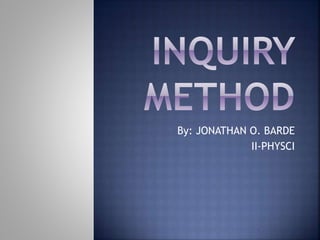INQUIRYMETHOD
•Als PPTX, PDF herunterladen•
27 gefällt mir•28,537 views
Inquiry education (sometimes known as the inquiry method) is a student-centered method of education focused on asking questions..
Melden
Teilen
Melden
Teilen

Empfohlen
Empfohlen
Weitere ähnliche Inhalte
Was ist angesagt?
Was ist angesagt? (20)
Meaning, definitions & need of educational research.

Meaning, definitions & need of educational research.
Life Oriented Curriculum And Interdisciplinary Curriculum

Life Oriented Curriculum And Interdisciplinary Curriculum
Ähnlich wie INQUIRYMETHOD
Ähnlich wie INQUIRYMETHOD (20)
Learner: Definition and theories of learning, Student’s Learning Style, and T...

Learner: Definition and theories of learning, Student’s Learning Style, and T...
ELE02_ONA-BAGAMAN Science Subject Inquiry Approach

ELE02_ONA-BAGAMAN Science Subject Inquiry Approach
Mehr von BSEPhySci14
Mehr von BSEPhySci14 (20)
Kürzlich hochgeladen
Kürzlich hochgeladen (20)
Sensory_Experience_and_Emotional_Resonance_in_Gabriel_Okaras_The_Piano_and_Th...

Sensory_Experience_and_Emotional_Resonance_in_Gabriel_Okaras_The_Piano_and_Th...
HMCS Max Bernays Pre-Deployment Brief (May 2024).pptx

HMCS Max Bernays Pre-Deployment Brief (May 2024).pptx
Beyond_Borders_Understanding_Anime_and_Manga_Fandom_A_Comprehensive_Audience_...

Beyond_Borders_Understanding_Anime_and_Manga_Fandom_A_Comprehensive_Audience_...
On National Teacher Day, meet the 2024-25 Kenan Fellows

On National Teacher Day, meet the 2024-25 Kenan Fellows
Python Notes for mca i year students osmania university.docx

Python Notes for mca i year students osmania university.docx
UGC NET Paper 1 Mathematical Reasoning & Aptitude.pdf

UGC NET Paper 1 Mathematical Reasoning & Aptitude.pdf
HMCS Vancouver Pre-Deployment Brief - May 2024 (Web Version).pptx

HMCS Vancouver Pre-Deployment Brief - May 2024 (Web Version).pptx
Basic Civil Engineering first year Notes- Chapter 4 Building.pptx

Basic Civil Engineering first year Notes- Chapter 4 Building.pptx
Micro-Scholarship, What it is, How can it help me.pdf

Micro-Scholarship, What it is, How can it help me.pdf
This PowerPoint helps students to consider the concept of infinity.

This PowerPoint helps students to consider the concept of infinity.
INQUIRYMETHOD
- 1. By: JONATHAN O. BARDE II-PHYSCI
- 2. Inquiry education (sometimes known as the inquiry method) is a student-centered method of education focused on asking questions..
- 3. Students are encouraged to ask questions which are meaningful to them, and which do not necessarily have easy answers; teachers are encouraged to avoid giving answers when this is possible, and in any case to avoid giving direct answers in favor of asking more questions.
- 4. The method was advocated by Neil Postman and Charles Weingartner in their book Teaching as a Subversive Activity.
- 5. The inquiry method is motivated by Postman and Weingartner's recognition that good learners and sound reasoners center their attention and activity on the dynamic process of inquiry itself, not merely on the end product of static knowledge.
- 6. They write that certain characteristics are common to all good learners (Postman and Weingartner, ), saying that all good learners have: Self-confidence in their learning ability Pleasure in problem solving A keen sense of relevance Reliance on their own judgment over other people's or society's No fear of being wrong No haste in answering Flexibility in point of view
- 7. Respect for facts, and the ability to distinguish between fact and opinion No need for final answers to all questions, and comfort in not knowing an answer to difficult questions rather than settling for a simplistic answer
- 8. In an attempt to instill students with these qualities and behaviors, a teacher adhering to the inquiry method in pedagogy must behave very differently from a traditional teacher.
- 9. . Postman and Weingartner suggest that inquiry teachers have the following characteristics :
- 10. • They avoid telling students what they "ought to know". • They talk to students mostly by questioning, and especially by asking divergent questions. • They do not accept short, simple answers to questions. • They encourage students to interact directly with one another, and avoid judging what is said in student interactions. • They do not summarize students' discussion.
- 11. They do not plan the exact direction of their lessons in advance, and allow it to develop in response to students' interests. Their lessons pose problems to students. • They gauge their success by change in students' inquiry behaviors (with the above characteristics of "good learners" as a goal).
- 12. 1. Define the topic or introduce the topic. 2. Guide students to plan where and how to gather data, information. they may research on the topic/question by viewing, reading constructing, experimenting and observation. 3. Students present findings through graphs, charts, powerpoint presentation, models and drawing.
- 13. For example, when discussing the internal structure of the earth, a teacher will often give the students information about just the names and sizes of these earth layers, or the "what we know." But what really is important and intriguing for the student is the "how do we know?" about these structures. No one has been down there, and physical probes have only scratched the surface.
- 14. To enhance inquiry learning, the teacher should explain that indirect scientific evidence, mainly the transmission and reflection of different kinds of earthquake waves, provides much of our understanding about the internal structure of the earth. This approach provides the student with the opportunity not only to learn the names and sizes of the structures but, more importantly, to ponder and question the nature of indirect scientific evidence as well.
- 15. Thus, an inquiry approach can help students connect science with the scientific method. Students learn to apply the method to various fields of study while coming to understand their content.
- 16. Its emphasis is on the process of gathering and processing more information. The inquiry approach which predominantly allows some degree of freedom develops initiative and divergent thinking. A deep sense of responsibility is developed when learners are left to manage their own leaning.
- 17. Educators strongly believe that facts and concepts that learners discover themselves become stored as part of their permanent learning. Experiencing success in inquiry-based/ discovery lessons build up the learners feeling of confidence. Participation in inquiry activities strengthens learners intellectual capabilities.
- 18. Prepared by: JONATHAN O. BARDE II-PHYSCI PREPARED TO: MR. CARLO M. CORNEJO Instructor
- 19. PRINCIPLES OF TEACHING 1 By: Brenda B. Corpuz, Ph.D. Gloria G. Salandanan, Ph.D. WIKEPEDIA www.inquirymethod/wikepedia.yahoo. com.ph.
